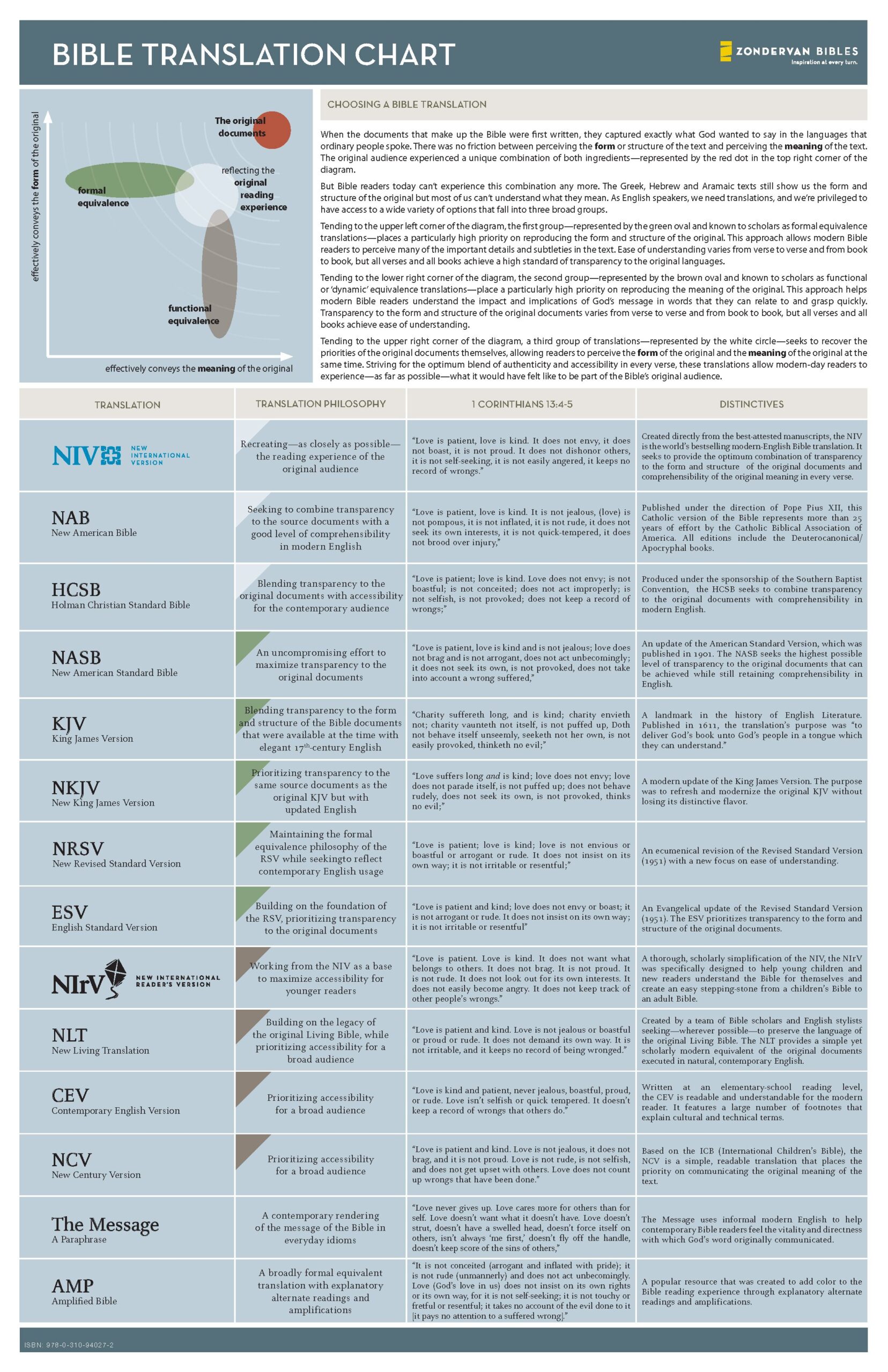Why ESV?

Question: What Bible translation do you teach from and why?
Answer: We teach from the English Standard Version (ESV). The reason we choose the ESV requires an understanding of some of the basic doctrines of Bible translation.
Bible Translation Made Simple (At least a try…)
A friend of mine once sold Bibles door-to-door to make money during his summer college breaks. It was not unusual for him to hear a potential buyer proclaim to him when choosing the translation they wanted…”I want the King James…if it was good enough for Jesus, it’s good enough for me!”
As silly as that may sound, it does remind us that not everyone has even a cursory understanding of Bible translation. And to be honest, for 300 years no one needed to, as the King James Bible had a virtual lock on the Bible market. But things have changed, and for better or worse (I think for better), today we have virtual cornucopia of Bible translations from which we can choose.
The problem is we often do not have a clear and understandable framework for evaluating which Bible will be best for us. So, here is a brief, but helpful explanation of what goes into Bible translations.
Since the Bible was written in Hebrew (Old Testament) and Greek (New Testament), translations are necessary for English readers to be able to read and understand the text. It is agreed that all translations have the same primary goal:
"To take a text in one language and reproduce its meaning in another language."
- Mark Strauss, NT Professor at Bethel Seminary
The ultimate goal of any translation is “meaning.” And the question for translators is how best to take the biblical meaning the authors intended, which was originally communicated in Hebrew and Greek, and get that “meaning” to the English reader. (By the way, this is the question for getting the Bible into ALL languages of the world, not just English speaking.)
The objection might be raised, “I don’t want the translators to give me the meaning of the word, I want them to just translate the word.” But think for a moment about words and their meanings. Professor Strauss cites the English word “key” as an example. It can mean:
- A tool to unlock a door
- Primary
- A button
- A small offshore island
- A musical pitch
When translating the Hebrew/Greek to the English language, the translator MUST interpret what the author intends the word to mean in the original language and context, before they can find an equivalent word in the English language. We say this to say, there is NO Bible translation in which “interpretation” is not a necessary part of the translation process.
Translation Philosophies (Why we have so many different translations)
The clearest way to understand translation philosophies is to see them on a continuum.
-
Word-for-Word Translations
On the left side of the continuum are translations which seek to adhere as closely as possible to a “word-for-word” translation. That is, they seek to make the translation not only as close in meaning, but also in structure (the order of the words in the Greek text).
-
Thought-for-Thought Translations
In the middle are translations that seek to convey as closely as possible the authors thought, not simply the specific words or word order. In “thought-for-thought” translation the meaning the author intends takes precedence over the structure of the original language.
-
Paraphrase Translations
Many do not consider Bibles in this part of the spectrum “translations” at all. The reason is that the goal of a paraphrase is to enhance the original in such a way that while it seeks to remain true to the original meaning, it adds language that makes the original text easier to read and fuller in meaning.

So, let’s try this again…
Question: What Bible translation do you teach from and why?
Answer: We teach from the English Standard Version (ESV). Because we believe the “word-for-word” translation is better suited to expositional teaching, which is the way we teach the Bible at Fellowship each weekend. Expositional teaching is focused on explaining the meaning of a Bible text in its historical and grammatical context, with application in our present-day context.
The ESV seeks to retain strength of the NASB’s “formal” translation, while at the same time smoothing out word choice and order so that is more easily read and understood privately and publicly.
Question: What is the best translation?
Answer: Having read the primer on biblical translation above, we hope you see that there is no “best” translation. There are many, many very good translations. If you are reading from any of the translations listed on the chart above, you can be sure that you are getting a translation from biblical scholars who have done their best to bring the original language and meaning of the Scripture to an English translation you can trust. It may go without saying, but our hope is that you will have more than one Bible translation that you use for reading, for studying and for devotions. Each one can help us see, hear and apply the message of the Scriptures more readily.
Additional Resources
To learn more regarding Bible translations, visit these excellent websites:
- How Not to Argue About Which Bible Translation Is Best (The Gospel Coalition)
- How do You Choose A Bible Translation? (Tim Challies)
- Fifteen Myths about Bible Translation (Daniel B. Wallace)
- Bible Translation Today (Christianity Today)


